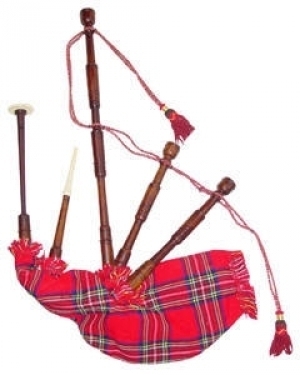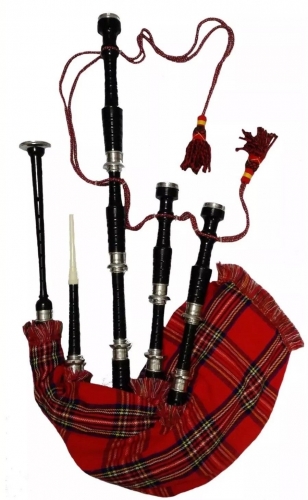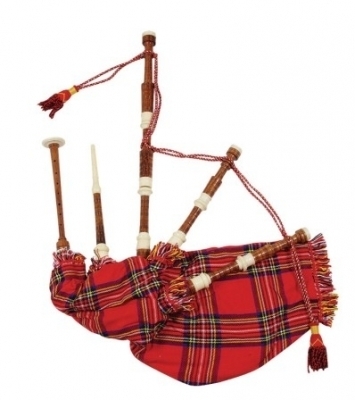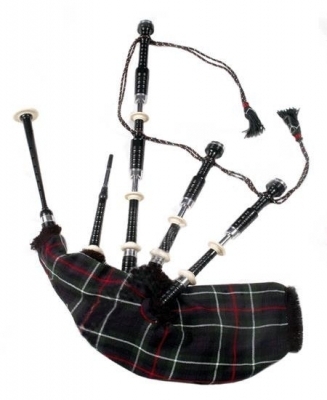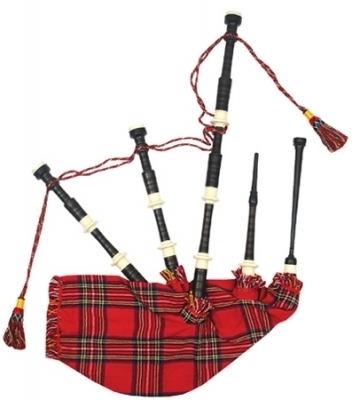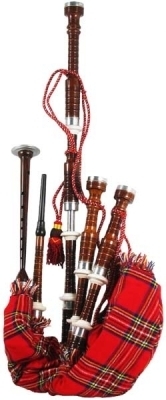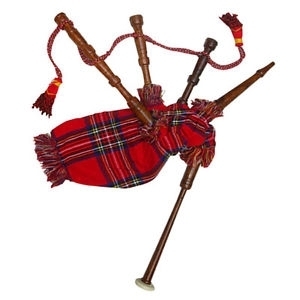The bagpipe is a traditional musical instrument that has deep historical and cultural roots, especially in Celtic regions, including Scotland and Ireland. It is a wind instrument that uses enclosed reeds fed from a constant reservoir of air in a bag. The player, known as a piper, controls the flow of air into the bag and produces music by playing melody and harmony on the instrument’s various pipes.
- Bag:
- The bag is typically made of leather or synthetic materials and serves as an airtight reservoir for the constant supply of air to the instrument. The piper inflates the bag with air using their mouth and arm pressure.
- Chanter:
- The chanter is the main melody pipe of the bagpipe. It has finger holes that the piper uses to produce different notes, creating the melody of the music.
- Drones:
- Bagpipes have one or more drones, which are additional pipes that produce a continuous tone beneath the melody. Drones add depth and resonance to the music.
- In a typical set of bagpipes, there are three drones: one bass drone and two tenor drones. Each drone produces a single, sustained pitch.
- Reeds:
- The reeds are essential components of the bagpipe. The chanter reed produces the melody, while the drone reeds provide a constant tone. Proper maintenance and tuning of the reeds are crucial for achieving a harmonious sound.
- Blowpipe:
- The blowpipe is the tube through which the piper inflates the bag with air. It has a mouthpiece at one end for the piper to blow into.
- Bag Cover and Cord:
- The bag is often covered with a decorative fabric or cover, and a cord may be wrapped around the top to help maintain the bag’s shape and pressure.
-
Bagpipe Antique Brown wood Royal Stewart Cover
TRE-04- Bagpipe Full size , Royal Stewart Tartan cover Antique Design in Brown wood with all reeds included. High Quality Pipes with Professional sound quality One set of Pakistani drone reeds and English cane chanter reed is also fitted. ( ready to play )
-
Bagpipe Black finish PLAIN Nickel Silver Fitting
TRE-11- a black bagpipe with plain nickel silver fittings offers a timeless and elegant option for enthusiasts and musicians who appreciate the traditional craftsmanship and classic appearance of bagpipes.
-
Bagpipe Brownwood Ivory Plastic fitting Royal Stewart Tartan Cover
TRE-05- Brown Wood bagpipe, Royal Stewart Tartan Bag cover with cord, with White Plastic Sole and Knobs with soft leather bag. Naturally Finished Seasoned Bagpipe High Quality Pipes with Professional sound quality One set of Pakistani drone reeds and English cane chanter reed is also fitted. ( ready to play
-
Black Ebony Wood Bagpipe turned Plain nickel Ivory Plastic Fitting
TRE-10- Black Ebony Wood Bagpipe, Mackenzie Tartan Bag cover with cord, with turned Plain Plain nickel Ivory Plastic Fitting with Synthetic Air Tight bag.
-
Blackwood Bagpipe Ivory Color Plastic Fitting
TRE-09- Full Size Highland blackwood Bagpipe Natural Matt Finished Seasoned black wood, Ivory Color Knobs, Scrolls & Sole.
-
Brown Wood bagpipe Plain nickel silver fitting
TRE-06- brown wood bagpipe with plain nickel silver fittings offer a combination of durability, sound quality, and aesthetic appeal appreciated by both beginner and experienced players. Their classic design and versatile sound make them a popular choice among bagpipe enthusiasts worldwide.
-
Toy Kid Dummy Bagpipe Brown wood Chanter
TRE-01- A toy kid dummy bagpipe is a child-friendly version of a traditional bagpipe instrument designed for play rather than serious music-making. These toy bagpipes typically mimic the appearance of real bagpipes but are made from lightweight and safe materials suitable for children. They may feature simplified functionality, such as fewer or non-functional drone pipes, and may produce sound through a…


